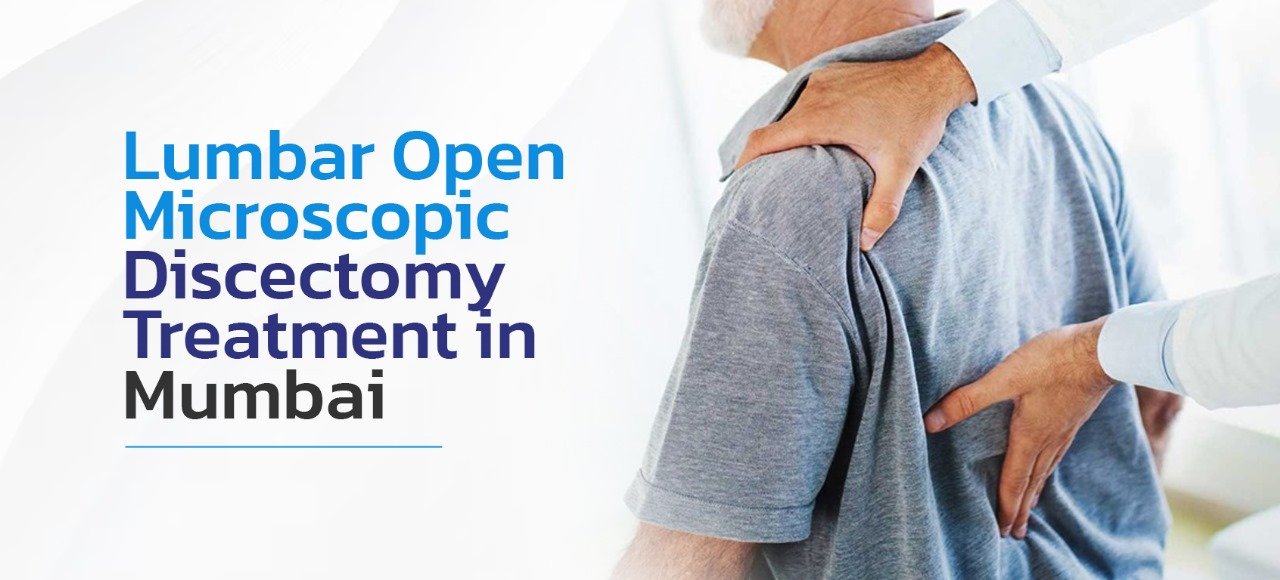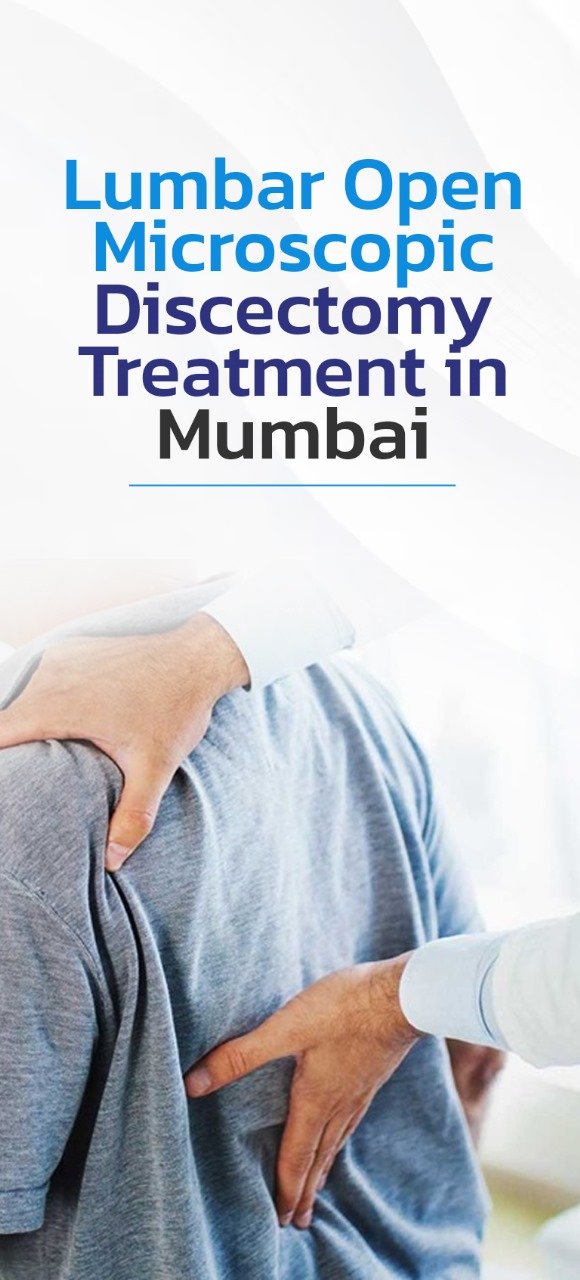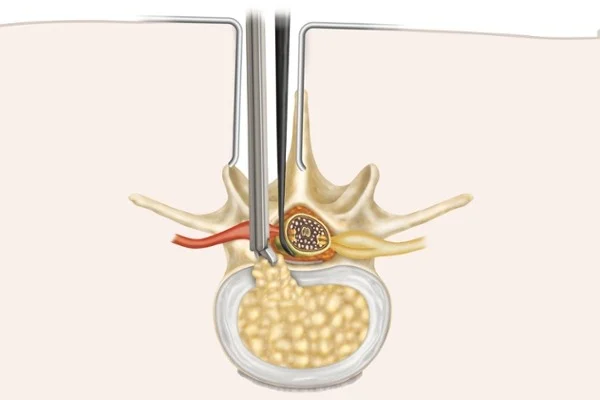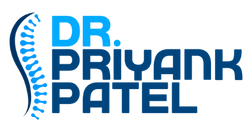

Unlocking Relief: Exploring the Benefits of Lumbar Open Microscopic Discectomy Treatment in Mumbai"
Lumbar open microscopic discectomy, a minimally invasive surgical procedure, stands as a beacon of hope for individuals grappling with debilitating lower back pain caused by herniated discs. This innovative approach combines precision and minimal disruption to swiftly alleviate discomfort, allowing patients to regain their mobility and quality of life with enhanced spinal health. Explore advanced Lumbar Open Microscopic Discectomy treatment in Mumbai for a comprehensive solution to your spinal concerns.

Looking for Lumbar Open Microscopic Discectomy Treatment in Mumbai? Consult Dr. Priyank Patel.
Are you in search of a premier lumbar open microscopic discectomy treatment in Mumbai? Look no further than Dr. Priyank M. Patel, a distinguished orthopedic surgeon with a specialization in the surgical and non-surgical management of spine-related disorders. Dr. Patel’s credentials include an MS in Orthopedics and extensive international training in advanced techniques such as minimally invasive spinal surgery, computer-assisted spinal surgery, and microsurgery. With a sub-specialty in spine tumors, he has earned recognition as one of the youngest independent surgical consultants in India, empaneled at a leading tertiary hospital in Mumbai.
Beyond his surgical prowess, Dr. Patel advocates for a conservative approach when feasible, emphasizing an active lifestyle supplemented with corrective exercises and strength training. His holistic approach has benefited not only the general population but also professional athletes from the Indian National Cricket Team and the film industry. Dr. Patel, recognized as the best lumbar open microscopic discectomy doctor in Mumbai and a lumbar open microscopic discectomy specialist in Mumbai, actively contributes to philanthropic work, including the setup of rural spine care centers. His commitment extends to aspiring to establish a National Spine Tumor Foundation. When it comes to lumbar open microscopic discectomy, consulting with Dr. Priyank Patel ensures comprehensive and expert care.
What is Lumbar Open Microscopic Discectomy?
Lumbar open microscopic discectomy (LOMD) is a surgical procedure designed to address issues related to herniated or damaged discs in the lumbar spine. This minimally invasive technique aims to alleviate debilitating lower back pain caused by the compression of spinal nerves. Here are some key points to understand about LOMD
- Precise Intervention: LOMD utilizes advanced surgical instruments and a specialized microscope to provide enhanced visibility of the affected disc. This precision allows surgeons to target the specific area of the herniation with minimal disruption to surrounding tissues.
- Minimal Tissue Disruption: Unlike traditional open surgery, LOMD involves making a small incision, resulting in reduced trauma to the muscles and ligaments surrounding the spine. This approach helps minimize postoperative pain and promotes a faster recovery process.
- Nerve Decompression: The primary objective of LOMD is to remove the herniated portion of the disc, thereby relieving pressure on the nerves and restoring normal spinal function. By alleviating nerve compression, LOMD can effectively reduce symptoms such as radiating pain, numbness, and weakness in the legs.
- Preservation of Healthy Tissue: LOMD aims to preserve as much healthy tissue as possible while addressing the disc abnormality. This aspect of the procedure is crucial for maintaining overall spinal stability and function.
- Advantages Over Traditional Surgery: LOMD offers several advantages over traditional open surgery, including shorter hospital stays, reduced risk of complications, and a faster return to normal activities. These benefits make LOMD an attractive option for individuals seeking effective relief from lumbar spine issues. If you’re considering Lumbar Open Microscopic Discectomy treatment in Mumbai or require expert Lumbar Open Microscopic Discectomy surgery in Mumbai, this minimally invasive procedure can provide significant relief with precision and efficiency.
What is Lumbar Open Microscopic Discectomy?
Indications for Lumbar Open Microscopic Discectomy (LOMD) are crucial considerations for individuals facing specific lumbar spine issues. These indications include-
- Herniated Discs: LOMD is often recommended for those grappling with herniated or bulging discs in the lumbar spine, where the inner gel-like material protrudes, causing nerve compression and necessitating precise intervention.
- Radicular Pain: Indicative of nerve compression, radicular pain prompts the consideration of LOMD to alleviate pressure on affected nerve roots, providing relief from radiating pain sensations.
- Leg Weakness and Numbness: Persistent numbness and weakness in the legs, arising from lumbar nerve compression, may signal the need for LOMD to address the underlying cause and enhance leg function.
- Failed Conservative Treatments: When conventional approaches like physical therapy and medication fall short in providing relief, LOMD becomes a viable option, particularly for those seeking effective resolution of lumbar spine issues.
- Diagnostic Confirmation: LOMD serves as a diagnostic tool, especially in cases where the precise cause of lower back pain is uncertain. The microscopic visualization aids in confirming disc abnormalities and facilitates targeted treatment.
- Recurrent Lumbar Disc Herniation: In instances of recurring disc herniation post-surgery, LOMD is considered to address renewed symptoms, providing a surgical solution to recurrent lumbar disc issues.
For individuals facing these indications, consulting with a qualified healthcare professional is crucial. If you are in Mumbai, exploring options for Lumbar Open Microscopic Discectomy treatment in Mumbai and seeking a skilled Lumbar Open Microscopic Discectomy surgeon in Mumbai is imperative for personalized care and optimal outcomes.
Who is a candidate?
Candidates for Lumbar Open Microscopic Discectomy (LOMD) are individuals experiencing specific conditions and symptoms related to lumbar spine issues. Potential candidates typically include those who-
- Herniated Disc Patients: Individuals diagnosed with herniated or bulging discs in the lumbar spine, where the inner material of the disc presses against nerves, causing pain and discomfort.
- Radicular Pain Sufferers: Those experiencing radicular pain, characterized by pain radiating along the nerve pathway, often due to nerve compression in the lumbar region,.
- Leg Weakness and Numbness: Individuals with persistent weakness and numbness in the legs, indicative of nerve compression, may be candidates for LOMD to address the underlying issue.
- Failed Conservative Treatment Recipients: Individuals who have undergone conservative treatments such as physical therapy and medication without significant relief and continue to experience lumbar spine issues.
- Diagnostic Uncertainty Cases: Patients for whom the cause of lower back pain is unclear and further diagnostic confirmation is needed through direct visualization with a microscope.
- Recurrent Lumbar Disc Herniation Cases: Individuals who have previously undergone lumbar disc surgery and are now experiencing a recurrence of disc herniation, leading to renewed symptoms.
For those considering Lumbar Open Microscopic Discectomy treatment in Mumbai, it’s essential to factor in considerations such as potential candidacy, personalized evaluations, and consultations with healthcare professionals. Additionally, understanding the cost of lumbar open microscopic discectomy surgery in Mumbai is a crucial aspect of informed decision-making and optimal planning.
Lumbar Open Microscopic Discectomy Surgical Procedure
The Lumbar Open Microscopic Discectomy (LOMD) surgical procedure is a specialized intervention designed to address lumbar spine issues, particularly those arising from herniated or damaged discs. Here is an overview of the key steps involved in the LOMD surgical process:
- Patient Positioning: The patient is positioned face down on the operating table, allowing the surgeon optimal access to the lumbar spine.
- Anesthesia Administration: General anesthesia is typically administered to ensure the patient remains unconscious and pain-free throughout the procedure.
- Incision: A small incision, usually less than an inch in size, is made over the affected area of the spine. This minimal incision is a hallmark of the minimally invasive nature of LOMD.
- Microscope Utilization: A specialized microscope is employed to magnify and illuminate the surgical area, providing the surgeon with a clear and detailed view of the lumbar spine structures.
- Tissue Displacement: Muscles and tissues are gently moved aside to access the affected disc without the need for extensive tissue disruption. This approach minimizes trauma to surrounding structures.
- Disc Removal: The surgeon carefully removes the herniated or damaged portion of the disc causing nerve compression. This step aims to alleviate pressure on the nerves and relieve associated symptoms
- Nerve Decompression: If necessary, additional decompression may be performed to address any pressure on nerve roots in the lumbar region.
- Closure: Once the disc issue is resolved, the incision is meticulously closed with sutures. The small incision size contributes to reduced scarring and faster healing.
- Postoperative Monitoring: The patient is moved to a recovery area, where vital signs are monitored as they wake from anesthesia. Postoperative care includes pain management and monitoring for any immediate complications.
The Lumbar Open Microscopic Discectomy surgical procedure is characterized by its precision and minimally invasive approach, allowing for a quicker recovery compared to traditional open surgeries. For individuals seeking the best lumbar open microscopic discectomy doctor in Mumbai, it’s essential to consult with a skilled and experienced healthcare professional for personalized care and optimal outcomes. Patients are encouraged to explore options for Lumbar Open Microscopic Discectomy treatment in Mumbai, with a focus on comprehensive and expert medical attention.

Lumbar Open Microscopic Discectomy: Preoperative Preparation?
Preoperative preparation for lumbar open microscopic discectomy (LOMD) is a crucial phase aimed at ensuring the patient is physically and mentally ready for the surgical procedure. Here are key aspects of the preoperative preparation process:
- Medical Evaluation: Patients undergo a comprehensive medical evaluation to assess their overall health and identify any underlying conditions that might impact the surgery or recovery.
- Imaging Studies: Diagnostic tests, such as MRI or CT scans, are conducted to precisely visualize the lumbar spine and identify the location and extent of the disc herniation or damage.
- Medication Review: The healthcare team reviews the patient’s current medications, including prescription and over-the-counter drugs, to determine if any adjustments or temporary discontinuations are necessary before the surgery.
- Fasting Instructions: Patients are typically instructed to refrain from eating or drinking for a specified period before the surgery. This fasting helps prevent complications related to anesthesia.
- Smoking Cessation: For individuals who smoke, quitting or reducing smoking is encouraged before surgery. Smoking can impair healing and increase the risk of complications.
- Blood Tests: Routine blood tests may be performed to assess blood clotting function and ensure that the patient is in an optimal state for surgery.
- Preoperative Education: Patients receive detailed information about the LOMD procedure, including the expected outcomes, potential risks, and postoperative care instructions. This education helps alleviate anxiety and ensures informed decision-making.
- Home Preparation: Patients are advised to make necessary arrangements for their postoperative recovery, including setting up a comfortable and supportive environment at home. This may involve arranging for assistance with daily activities during the initial recovery period.
- Follow-up Consultations: Patients attend preoperative consultations with the surgical team, providing an opportunity to address any concerns or questions. This ensures clear communication and fosters a collaborative approach to care.
- Postoperative Planning: The healthcare team discusses postoperative care, including pain management, physical therapy, and follow-up appointments. Understanding the postoperative plan contributes to a smoother recovery process.
- Support System: Establishing a support system is crucial. Patients are encouraged to communicate their needs to family members or friends who can provide assistance during the recovery phase.
Effective preoperative preparation plays a vital role in optimizing the overall surgical experience, especially for those seeking Lumbar Open Microscopic Discectomy treatment in Mumbai. Through a collaborative effort between the patient and the healthcare team, individuals can approach the surgery with confidence and a clear understanding of the process, guided by an experienced Lumbar Open Microscopic Discectomy doctor in Mumbai.
What happens during surgery?
During Lumbar Open Microscopic Discectomy (LOMD) surgery, the following steps typically occur:
- Patient Positioning: The patient is positioned face down on the operating table to allow the surgeon optimal access to the lumbar spine.
- Anesthesia Administration: General anesthesia is administered to ensure the patient is unconscious and pain-free throughout the procedure.
- Incision: A small incision, usually less than an inch in size, is made over the affected area of the spine. This minimally invasive approach distinguishes LOMD from traditional open surgeries.
- Microscope Utilization: A specialized microscope is employed to magnify and illuminate the surgical area. This provides the surgeon with a clear and detailed view of the lumbar spine structures.
- Tissue Displacement: Muscles and tissues are gently moved aside to access the affected disc without extensive tissue disruption. Minimizing trauma to surrounding structures is a key aspect of LOMD.
- Disc Removal: The surgeon carefully removes the herniated or damaged portion of the disc that is causing nerve compression. This step aims to alleviate pressure on the nerves and relieve associated symptoms.
- Nerve Decompression: Additional decompression may be performed if necessary to address any pressure on nerve roots in the lumbar region.
- Closure: Once the disc issue is resolved, the incision is meticulously closed with sutures. The small incision size contributes to reduced scarring and faster healing.
- Postoperative Monitoring: The patient is moved to a recovery area where vital signs are monitored as they wake from anesthesia. Postoperative care includes pain management and monitoring for any immediate complications.
Throughout the procedure, the surgeon, often recognized as a Lumbar Open Microscopic Discectomy Specialist in Mumbai, follows a precise and targeted approach to address the specific lumbar spine issue. The use of a microscope enhances visibility, allowing for a more accurate and minimally invasive intervention. The overall goal of LOMD is to provide effective relief from symptoms associated with disc herniation while minimizing disruption to surrounding tissues, making it an ideal choice for those seeking advanced Lumbar Open Microscopic Discectomy treatment in Mumbai.
Lumbar Open Microscopic Discectomy: Postoperative Care?
Postoperative care following a lumbar open microscopic discectomy (LOMD) is crucial for a successful recovery and optimal outcomes. Here’s a comprehensive guide to the key aspects of postoperative care:
- Recovery Room Monitoring: After the surgery, patients are moved to a recovery room where their vital signs, such as heart rate, blood pressure, and oxygen levels, are closely monitored as they wake from anesthesia.
- Pain Management: Pain management is initiated to ensure the patient’s comfort. Medications, both oral and intravenous, may be prescribed to alleviate postoperative pain.
- Incision Care: Proper care of the incision site is essential. The surgical team provides instructions on how to keep the incision clean and dry to prevent infection. Patients should report any signs of infection, such as redness, swelling, or discharge.
- Activity Restrictions: Initially, there will be restrictions on certain activities to avoid strain on the surgical site. Patients are typically advised to avoid heavy lifting, bending, and strenuous activities during the early stages of recovery.
- Physical Therapy: Depending on the surgeon’s recommendation, physical therapy may be initiated to help regain strength and flexibility. Specific exercises are tailored to the individual’s condition and are gradually introduced.
- Follow-up Appointments: Regular follow-up appointments with the surgeon are scheduled to monitor the progress of the recovery. During these appointments, any concerns or issues can be addressed, and the surgeon can assess the healing process.
- Gradual Resumption of Activities: Patients are guided on when and how to gradually resume normal activities. This may include returning to work, driving, and engaging in regular daily tasks. The timeline for resumption varies based on individual recovery progress.
- Pain Medication Tapering: As the postoperative pain diminishes, the need for pain medications may decrease. The healthcare team will provide guidance on tapering off pain medications safely.
- Monitoring for Complications: Patients should remain vigilant for any signs of complications, such as persistent or worsening pain, new neurological symptoms, or signs of infection. Prompt reporting of any concerns to the healthcare team is essential.
- Lifestyle Modifications: The healthcare team may provide guidance on lifestyle modifications to support long-term spinal health. This may include recommendations for posture, ergonomics, and exercises to maintain a healthy spine.
- Emotional Well-Being: Acknowledging and addressing the emotional aspects of recovery is crucial. Support from family, friends, and, if needed, counseling services can contribute to a positive recovery experience.
Adhering to the prescribed postoperative care plan is essential for individuals seeking the best treatment for lumbar open microscopic discectomy in Mumbai. Maintaining open communication with the healthcare team and following the recommended guidelines contribute to a successful recovery after LOMD. Each individual’s recovery is unique, and the postoperative care plan is tailored to address specific needs and challenges.
Lumbar Open Microscopic Discectomy: Recovery and Prevention
Recovery and prevention play integral roles in the success of lumbar open microscopic discectomy (LOMD). Here’s a comprehensive guide to the postoperative phase and strategies for preventing future lumbar spine issues-
Recovery
- Immediate Postoperative Period: The initial days after LOMD involve careful monitoring in the hospital. Patients are observed for any signs of complications, and pain management is optimized.
- Activity Restrictions: During the first few weeks, patients are advised to avoid activities that could strain the surgical site. Restrictions may include lifting heavy objects, bending, and participating in high-impact activities.
- Incision Care: Proper care of the surgical incision is crucial. Patients receive instructions on keeping the incision clean and dry to prevent infection. Any signs of infection, such as redness or swelling, should be promptly reported to the healthcare team.
- Physical Therapy: The gradual introduction of physical therapy is common during the recovery period. Targeted exercises are designed to improve strength and flexibility in the lumbar region, aiding in overall recovery.
- Pain Management: Pain medication is prescribed as needed, and patients are advised on a gradual tapering schedule as pain diminishes. Adhering to the prescribed medication plan is essential.
- Follow-up Appointments: Regular follow-up appointments with the surgeon are scheduled to assess the progress of recovery. These appointments allow for any adjustments to the treatment plan and provide an opportunity for patients to discuss any concerns.
Prevention
- Lifestyle Modifications: Adopting a spine-friendly lifestyle is crucial. This may include maintaining a healthy weight, practicing good posture, and incorporating regular exercise into daily routines.
- Ergonomics: Paying attention to ergonomics in daily activities, such as sitting at a desk or lifting heavy objects, can significantly reduce the risk of future lumbar spine issues.
- Regular Exercise: Engaging in regular low-impact exercises, such as walking, swimming, or cycling, helps strengthen the muscles supporting the spine and promotes overall spinal health.
- Core Strengthening: Specific exercises targeting the core muscles can provide additional support to the spine. Consultation with a physical therapist can guide individuals in incorporating appropriate exercises into their routine.
- Healthy Nutrition: A well-balanced diet rich in calcium and vitamin D supports bone health. Adequate hydration is also essential for the intervertebral discs.
- Smoking Cessation: For individuals who smoke, quitting is strongly recommended. Smoking has been linked to slower healing and an increased risk of complications after spine surgery.
- Regular Check-ups: Periodic check-ups with a healthcare provider allow for the monitoring of spinal health and early intervention if any issues arise.
- Mindful Lifting: Practicing proper lifting techniques, such as bending at the knees and keeping the back straight, can prevent unnecessary strain on the lumbar spine.
- Weight Management: Maintaining a healthy weight reduces the load on the spine, decreasing the risk of disc herniation and other lumbar issues.
- Educational Resources: Staying informed about proper spine care through educational resources provided by healthcare professionals contributes to ongoing prevention efforts.
By actively participating in the recovery process and implementing preventive measures, individuals can enhance the long-term success of lumbar open microscopic discectomy treatment in Mumbai and promote overall spinal health.
Lumbar Open Microscopic Discectomy: Potential Risks and Complications
While lumbar open microscopic discectomy (LOMD) is generally considered a safe and effective procedure, like any surgical intervention, it carries potential risks and complications. It’s important for patients to be aware of these factors before undergoing the surgery. Here are some potential risks and complications associated with lumbar open microscopic discectomy treatment in Mumbai:
- Infection: There is a risk of postoperative infection at the incision site or within the spine. This risk is typically mitigated by maintaining strict sterile conditions during surgery and providing appropriate postoperative care.
- Bleeding: Though rare, excessive bleeding during or after surgery is a potential complication. Surgeons take precautions to minimize bleeding, and patients are monitored closely during the postoperative period.
- Nerve Damage: While the goal of LOMD is to relieve nerve compression, there is a small risk of inadvertent damage to nearby nerves during the procedure. This could lead to new or worsening neurological symptoms.
- Dural Tear: The dura is the protective covering around the spinal cord and nerves. In some cases, there may be an unintentional tear in the dura during surgery. This can lead to cerebrospinal fluid leakage and may require additional procedures to repair.
- Incomplete Relief of Symptoms: Despite a successful procedure, some patients may experience incomplete relief of symptoms or a recurrence of symptoms over time. This could necessitate further treatment or revision surgery.
- Blood Clot Formation: Prolonged immobility during and after surgery may increase the risk of blood clot formation. This risk is usually addressed with early postoperative mobilization and, in some cases, the use of blood-thinning medications.
- Anesthetic Complications: Adverse reactions to anesthesia, although rare, can occur. Patients undergo thorough preoperative evaluations to minimize the risk of such complications.
- Scar Tissue Formation: Some individuals may develop scar tissue around the surgical site, potentially leading to persistent pain or discomfort. Physical therapy and other interventions may be recommended to manage this issue.
- Disc Herniation at Adjacent Levels: In some cases, the increased stress on adjacent spinal discs after surgery may contribute to disc herniation at those levels. This is a known, but uncommon, complication.
- Persistent Pain: While the goal of LOMD is to alleviate pain, some patients may experience persistent or new pain after the surgery. Identifying and addressing the cause of this pain may require further evaluation.
It’s crucial for individuals considering a lumbar open microscopic discectomy to have a thorough discussion with their surgeon about the potential risks and complications. The decision to undergo surgery should be based on a comprehensive understanding of these factors, along with consideration of the expected benefits and alternatives. Surgeons aim to minimize risks through careful planning, precision during the procedure, and attentive postoperative care.

Lumbar Open Microscopic Discectomy Recovery and Rehabilitation
Recovery and rehabilitation are pivotal phases in the journey of Lumbar Open Microscopic Discectomy (LOMD) patients. Following surgery, a structured approach to recovery and rehabilitation is essential for optimal outcomes, especially for those considering Lumbar Open Microscopic Discectomy treatment in Mumbai. Here’s a comprehensive guide to the postoperative period-
Immediate Postoperative Period
- Hospital Stay: Most patients can expect a short hospital stay after LOMD. During this time, medical professionals monitor vital signs, manage pain, and ensure the initial stages of recovery are progressing well.
- Activity Restrictions: Patients are initially advised to limit certain activities to prevent strain on the surgical site. Avoiding heavy lifting, bending, and high-impact activities is crucial during the first few weeks.
- Pain Management: Adequate pain management is implemented to ensure patient comfort. Pain medications, both oral and intravenous, may be prescribed, and the healthcare team will provide guidance on their usage.
- Incision Care: Proper care of the surgical incision is emphasized. Patients receive instructions on keeping the incision clean and monitoring for any signs of infection. Regular follow-ups are scheduled to assess incision healing.
Physical Therapy and Rehabilitation
- Early Mobilization: As tolerated, early mobilization is encouraged. Short walks and gentle movements help prevent stiffness and promote circulation. Gradual resumption of daily activities is advised.
- Physical Therapy Sessions: A customized physical therapy plan is typically initiated. Therapists guide patients through exercises aimed at improving strength, flexibility, and overall spine function. Core-strengthening exercises may be emphasized.
- Posture Education: Education on maintaining proper posture during daily activities and work is provided. This helps prevent strain on the spine and promotes long-term spine health.
- Activity Graduation: Over time, patients progress to more demanding activities. The gradual resumption of activities is tailored to individual recovery, ensuring a balance between rebuilding strength and preventing complications.
- Monitoring Progress: Regular follow-up appointments with the surgeon allow for the monitoring of overall progress. Adjustments to the rehabilitation plan can be made based on the individual’s response to therapy.
- Return to Work: The timing of a return to work varies among individuals and depends on the nature of their occupation. The healthcare team provides guidance on when it is safe to resume work activities.
Patient Education and Lifestyle Adjustments
- Pain Management Strategies: Patients are educated on effective pain management strategies, including the proper use of medications and alternative methods such as ice or heat therapy.
- Healthy Lifestyle Choices: Emphasizing healthy lifestyle choices, including maintaining a balanced diet, staying hydrated, and avoiding tobacco use, contributes to overall well-being and supports the recovery process.
- Follow-up Imaging: In some cases, follow-up imaging studies may be recommended to assess the success of the surgery and ensure proper healing.
- Long-term Spine Health: Patients receive guidance on maintaining long-term spine health, which may involve ongoing exercises, regular check-ups, and lifestyle modifications.
Recovery and rehabilitation after a lumbar open microscopic discectomy are collaborative efforts between patients, healthcare providers, and rehabilitation professionals. A commitment to the prescribed rehabilitation plan enhances the likelihood of a successful recovery, allowing individuals to regain functionality and resume a more active and pain-free lifestyle, considering both the medical aspects and the Lumbar Open Microscopic Discectomy surgery cost in Mumbai.
In conclusion, Lumbar Open Microscopic Discectomy (LOMD) stands as a beacon of hope for those grappling with lower back pain. Dr. Priyank Patel, recognized as the best lumbar open microscopic discectomy doctor in Mumbai, combines surgical expertise with a holistic approach. The procedure’s precision, minimal tissue disruption, and quick recovery make it an attractive option. Aspiring patients in Mumbai seeking advanced Lumbar Open Microscopic Discectomy treatment can trust Dr. Patel’s comprehensive care, ensuring a path to restored spinal health and enhanced quality of life. For those considering lumbar open microscopic discectomy surgery in Mumbai, Dr. Patel’s expertise and commitment to individualized care make him a leading lumbar open microscopic discectomy surgeon in Mumbai. Understanding the cost of lumbar open microscopic discectomy surgery in Mumbai is crucial for informed decision-making, and Dr. Patel’s reputation as the best doctor for lumbar open microscopic discectomy in Mumbai ensures a comprehensive and expert approach.
Frequently Asked Questions
LOMD is a minimally invasive surgical procedure designed to address issues related to herniated or damaged discs in the lumbar spine. It aims to alleviate lower back pain caused by nerve compression.
LOMD involves a small incision and utilizes a specialized microscope for enhanced precision, resulting in minimal disruption to surrounding tissues. This approach leads to shorter recovery times compared to traditional open surgeries.
LOMD is recommended for herniated or bulging discs in the lumbar spine, causing symptoms such as lower back pain, radiating pain, numbness, and weakness in the legs.
Candidates are individuals with specific lumbar spine issues, including herniated discs, radicular pain, leg weakness, and numbness. Those who have not found relief with conservative treatments may also be candidates.
No, LOMD typically offers a faster recovery with reduced postoperative pain. Patients often experience shorter hospital stays and can resume normal activities sooner compared to traditional open surgeries.
The patient is positioned face down, a small incision is made, and a specialized microscope is used for magnification. The surgeon removes the herniated portion of the disc, alleviating nerve compression and promoting spinal health.
While considered safe, potential risks include infection, bleeding, nerve damage, and incomplete relief of symptoms. These risks are discussed thoroughly with the surgeon before the procedure.
Recovery times vary, but patients often experience significant improvement in the first few weeks. Full recovery may take several weeks to months, depending on individual factors and adherence to postoperative care.
Physical therapy is commonly recommended to improve strength and flexibility in the lumbar region. Therapists guide patients through exercises tailored to their condition, supporting their overall recovery.
Dr. Priyank Patel, recognized as the best LOMD doctor in Mumbai, specializes in both surgical and non-surgical spine management. His credentials, expertise, and holistic approach make him a trusted choice for lumbar open microscopic discectomy treatment.

